- 1Shaanxi Center of Mineral Geological of Geological Survey, Xi’an, Shaanxi, China
- 2Shaanxi Institute of Geological Survey, Xi’an, Shaanxi, China
Late Ordovician to early Silurian medium-acidic magmatic rocks with high Ba–Sr characteristics are well-exposed in the northern Qinling orogeny and are ideal objects for discussing the regional evolution of magmatism and constraint tectonics. The zircon U–Pb geochronology of quartz diorite in the northern Qinling terrane was assessed by laser-ablation inductively coupled plasma mass spectrometry and yielded a weighted mean age of 444 ± 3 Ma for 206Pb/238U, which was interpreted as the intrusion time of monzodioritic magma. The quartz diorite showed high Ba (357–886 ppm) and Sr (198–382 ppm) contents, consistent with the features of high Ba–Sr magmatic rocks. The high Ba–Sr quartz diorite samples showed high SiO2 and MgO contents of 58.26%–63.49% and 2.45%–3.20%, respectively, and possessed large FeOt/MgO ratios ranging from 1.71 to 2.02. In addition, the high Ba–Sr quartz diorite analyses were characterized by light-rare-earth-element-enriched as well as high-field-strength-element- and high-rare-earth-element-depleted patterns with moderate negative Eu anomalies (δEu = 0.61–0.81) as well as low ratios of Sr/Y (5–13) and (La/Yb)N (5–7), indicative of arc-magmatic-related affinities. Based on the above findings along with moderate Ba/Th, Ba/La, and Th/Nd ratios from the geochemical results, we propose that the high Ba–Sr quartz diorite was formed by partial melting of the enriched mantle wedge metasomatized by subduction fluids and melt interactions associated with the northward subduction of the Shangdan ocean. Therefore, the extensive late Ordovician magmatic activities driven by the metasomatic mantle wedge facilitated the early Paleozoic crustal growth of the northern Qinling orogeny.
1 Introduction
The Qinling orogenic belt is a collision-type orogenic belt located between the Longmenshan–Dabieshan fault and Sanmenxia fault in central China; it has undergone multiple phases of tectonic evolutions, including subduction and disappearance of the Shangdan ocean as well as the subsequent collision of the north China block and Yangtze block. The Qinling orogenic belt is mainly composed of the southern margin of the north China block, north Qinling block, south Qinling block, and northern margin of the Yangtze block from north to south, which are separated by the Luanchuan fault, Shangdan suture zone, and Mianlue suture zone, respectively (Dong et al., 2015; Zheng et al., 2023). Therefore, the Qinling orogenic belt has voluminous outcrops of magmatic rocks along the two suture zones that are documented evolutionary processes of the Shangdan and Mianlue oceans. In addition, these magmatic rocks are characterized by various types, large-span formation ages, and well-preserved outcrops as well as richness in the variety of mineral resources (Zheng et al., 2023; Wu et al., 2022; Zhao et al., 2024). Hence, the Qinling orogeny is an ideal area for studying the scientific problems of petrogenesis of magmatic rocks, mineralization, formation and evolution of an orogenic belt, crust–mantle interactions, and significance of the earth dynamics.
High Ba–Sr medium-acidic magmatic rocks were first discovered in the Scottish Caledonian orogenic belt (Tarney and Jones, 1994); these are characterized by high contents of Ba (>500 ppm) and Sr (>300 ppm) elements. Such high Ba–Sr magmatic rocks could be generated by partial melting of the oceanic plateaus (Tarney and Jones, 1994), partial melting of the mafic lower crust (Choi et al., 2009; Ye et al., 2008), and partial melting of the enriched mantle owing to metasomatism by asthenospheric carbonate melts or subduction zone fluids/melts (Eklund et al., 1998; Fowler et al., 2001; Peng et al., 2013). Therefore, high Ba–Sr rocks could provide important insights into the origins of orogenic magmatic rocks and deep-earth dynamic processes.
The north Qingling terrane has been found to preserve abundant amounts of Cambrian and early-middle Ordovician magmatic rocks (Dong et al., 2015). However, high Ba–Sr intermediate magmatic rocks have rarely been reported in this terrane. The present study focuses on the newly found high Ba–Sr quartz diorite deposits from the Honghuapu pluton in the northern segment of the Qinling orogeny. We conducted detailed zircon U–Pb geochronological, petrological, and geochemical studies to determine the formation age and origin of the quartz diorite while constraining its tectonic settings and deep dynamic processes.
2 Regional geological background
The Qinling orogenic belt extends over a distance of 1,500 km from east to west, starting from the Dabie orogenic belt in the east and ending at the Qilian–Kunlun orogenic belt in the west. The Qinling orogenic belt is sandwiched between the north China and south China blocks and is composed of the southern margin of the north China block, north Qinling terrane, south Qinling terrane, and northern margin of the south China block that are separated by the Luonan-Luanchuan-Fangcheng fault, Shangdan suture zone, and Mianlue suture zone, respectively (Wang, 1982; Li et al., 1997). Therefore, the Qinling orogenic belt outcrops numerous medium-acidic magmatic rocks and ophiolite belts because of regional orogenic uplift and erosion since the Mesozoic era. Studies have previously identified two important ophiolite belts, namely, the Shangdan and Mianlue ophiolite belts (Zhang et al., 1995; Dong et al., 1999; Dong et al., 2004; Lai et al., 2004); in addition, it is generally believed that the Qinling orogenic belt is mainly composed of three lithostratigraphic units, including a Precambrian metamorphic basement, Neoproterozoic–Mesozoic lithostratigraphy, and Meso-Cenozoic post-orogenic sedimentary and magmatic rocks (Zhang et al., 1995).
The Shangdan suture zone is the principal suture zone between the north and south China blocks (Dong et al., 2015); it represents the remnant oceanic crust after the subduction and closure of the Shangdan ocean in the Early Paleozoic (Figure 1a). The Shangdan suture zone outcrops a tectonic mélange composed of ophiolites, subduction-related volcanic rocks, and sedimentary rocks that has experienced superimposed tectonic movements, including the Paleozoic thrust, late Triassic left-lateral ductile shear, and Cretaceous brittle fault (Dong et al., 2015; Dong et al., 2011).
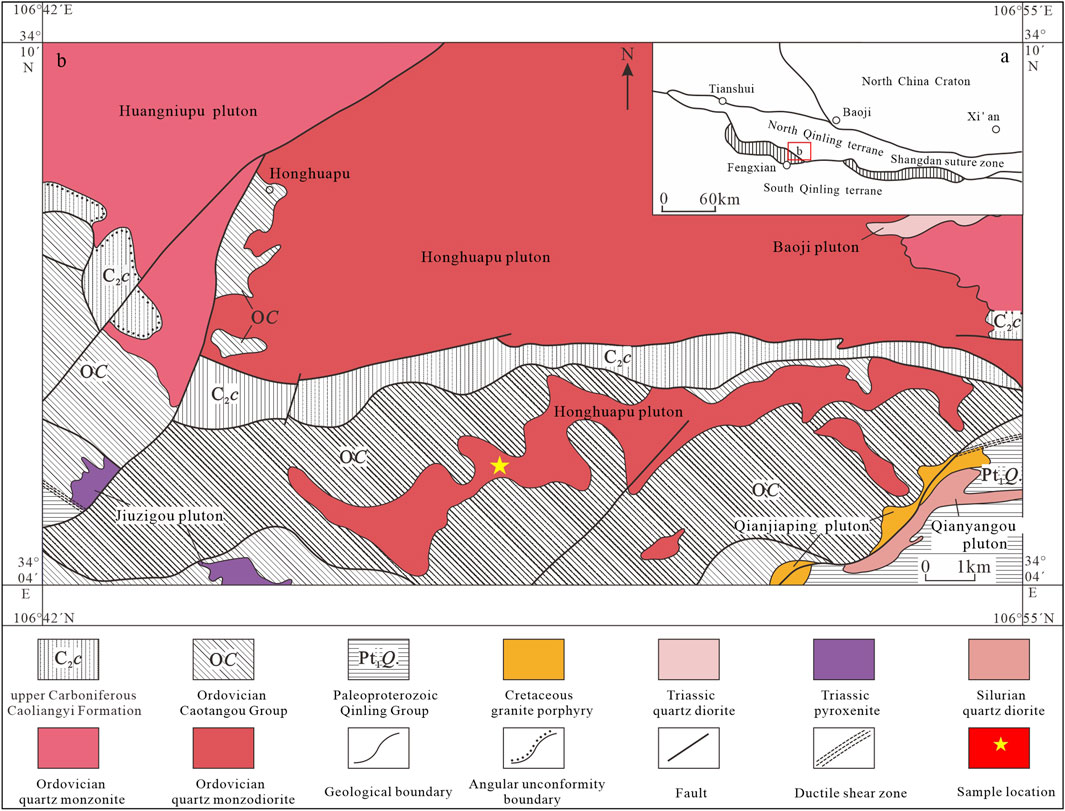
Figure 1. (a) Simplified tectonic map of the Qinling orogenic belt; (b) geological map of the study area modified from Wang et al. (2008).
The Honghuapu pluton near the Shangdan suture zone is located in the western segment of the north Qinling terrane and intrudes into the Ordovician Caotangou group as well as Huangniupu pluton (Figure 1b). The Caotangou group is mainly composed of basic to acidic volcanic rocks from basalt and andesite to dacite and rhyolite. The Huangniupu pluton comprises quartz diorite and amphibole-bearing quartz monzonite and was formed at ca. 450 Ma (Yao et al., 2017). Moreover, the area adjacent to the Honghuapu pluton shows outcrops of late Ordovician to early Silurian quartz diorite (440–425 Ma) (Chen et al., 2008; Ren, 2019).
3 Petrography
The Honghuapu quartz diorite is dark gray in color and is characterized by medium–fine-grained texture with a massive structure (Figure 2a); it is mainly composed of plagioclase (45%–50%), hornblende (30%–35%), quartz (∼10%), and K-feldspar (∼10%) along with minor accessory minerals like apatite and zircon (Figure 2b). The plagioclase is subhedral and tabular and displays polysynthetic twinning. The crystal faces of the grains are turbid with strong secondary sericitization and argillization characteristics. The hornblende is yellow–green to gray–green in color with distinct pleochroism and shows subhedral to euhedral and prismatic texture; in addition, the hornblende grains display well-developed rhombic cleavage and secondary chloritization. The K-feldspar grains are xenomorphic and distributed within the plagioclase grains. The quartz is xenomorphic with clean crystal surfaces as well as well-developed microfractures and deformation bands.
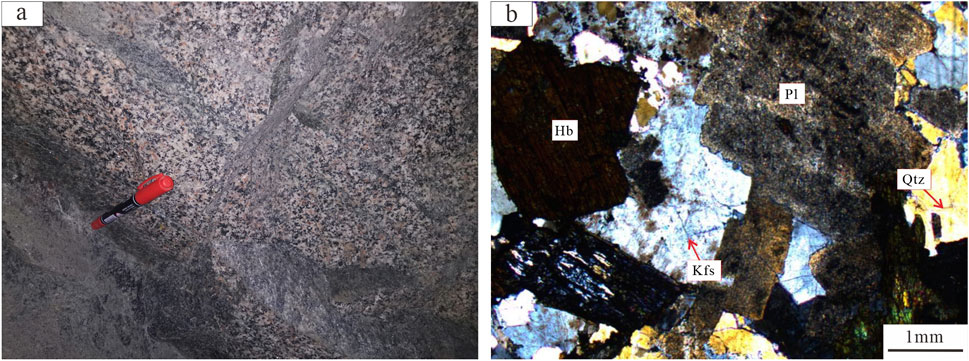
Figure 2. (a) Field photograph and (b) photomicrograph (under cross-polarized light) of the Honghuapu quartz diorite.
4 Sample collection and analyses
Samples were collected from fresh quartz diorite without veins (Figure 1b), and the rocks were geochemically analyzed at the Nuclear Industry No. 203 Institute. The major elements were analyzed by a wet chemical method according to the GB/T 14506.28-1993 standard, and the trace elements were analyzed by inductively coupled plasma mass spectrometry (ICP-MS). The international standards AGV-2, BHVO-2, and BCR-2 were used as references to estimate the analytical accuracy and precision. Zircon U–Pb dating was then conducted via laser-ablation inductively coupled plasma mass spectrometry (LA-ICP-MS) at the State Key Laboratory of Continental Dynamics, Northwest University. Zircon 91500 was selected as the external standard for U–Pb dating. The data were processed using the Glitter (v.4.0) program, and age calculations were performed using Isoplot (Ludwig, 2003). The procedures for the experimental analyses and data processing are available in previous reports (Yuan et al., 2003; Liu et al., 2002).
5 Results
5.1 Zircon U–Pb dating
In this study, zircon U–Pb dating was performed on sample 19D136-1 via LA-ICP-MS, and the results are presented in Supplementary Table S1. The zircons separated from the quartz diorite are light-yellow to colorless and are mostly prismatic with length-to-width ratios of 2–1.5. In the cathodoluminescence images, the zircon grains are relatively transparent with clear internal features and well-developed oscillatory zoning (Figure 3), possessing high Th/U ratios of 0.4–0.9. The lines of evidence suggest that zircons from the quartz diorite can be classified as magmatic origin (Wu and Zheng, 2004). Twenty-five dating experiments were conducted on 25 different zircon grains; all analyses were concordant or nearly concordant and yielded upper intercept and mean 206Pb/238U ages of 444 ± 3 Ma and 445 ± 3 Ma (mean-squared weighted deviation (MSWD) = 0.06), respectively (Figure 4), which are interpreted as the intrusion time of the Honghuapu quartz diorite.
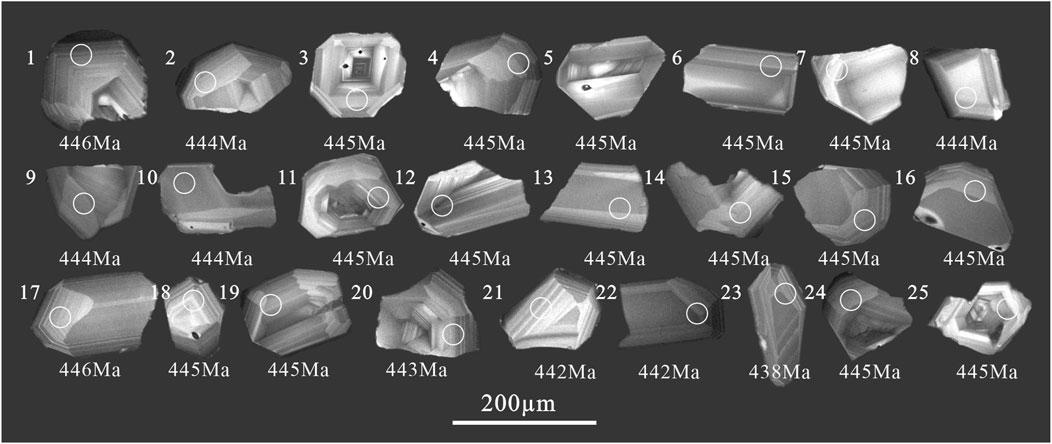
Figure 3. Cathodoluminescence (CL) images of the zircons analyzed from the Honghuapu quartz diorite. The white circles indicate the measured locations.

Figure 4. U–Pb Concordia diagrams of the Honghuapu quartz diorite showing the (a) upper intercept and (b) mean 206Pb/238U ages of the samples.
5.2 Whole-rock geochemistry
The quartz diorite in the Honghuapu pluton has a moderate amount of SiO2 (58.26%–63.49%) as well as relatively high amounts of MgO (2.45%–3.20%), Al2O3 (14.19%–15.74%), Fe2O3T (5.37%–6.09%), and Na2O (3.29%–5.02%) with a variable amount of K2O (1.36%–3.00%) (Supplementary Table S2). The total alkali content ranges from 5.97% to 6.85% and is characterized by low K2O/Na2O ratios (0.69–0.87), except for the sample 19D136-2 (K2O/Na2O = 0.27) whose value may be attributed to alterations (Figure 5a). The Honghuapu quartz diorite has relatively high Mg# values of 47–51 and moderate aluminum saturation index (A/CNK = 0.82–0.97) that are indicative of a metaluminous nature (Figure 5b). In the SiO2-K2O diagram, the majority of the analyzed samples appear to belong to the high potassic calc-alkaline series except for the sample 19D136-2 (Figure 5c).

Figure 5. (a) Total alkali silica diagram [after (Le Maitre, 1989)], (b) A/NK-A/CNK diagram [after (Peccerillo and Taylor, 1976)], and (c) SiO2-K2O diagram [after (Peccerillo and Taylor, 1976)] of the Honghuapu quartz diorite and adjacent dioritic samples with reference data from Ren (2019) and Liu et al. (2024). The dashed circles represent samples from the Honghuapu quartz diorite, dashed triangles represent the Huangniupu pluton, dashed squares represent the Tangzang-Yangjiazhuang pluton, and dashed crosses represent the Fanpu pluton. These symbols have the same meanings in all subsequent figures.
The Honghuapu quartz diorite shows significant fractionation between the different rare earth elements (REEs), where the light rare earth elements (LREEs) are enriched while the heavy rare earth elements (HREEs) are relatively depleted (Figure 6a); it has a slight-to-moderate negative Eu anomaly (δEu = 0.61–0.81). The total REE content varies from 118 to 177 ppm, while the LREE and HREE contents vary in the ranges of 103–153 ppm and 14–24 ppm, respectively, with the (La/Yb)n ratios ranging from 5 to 7. On the primitive mantle normalized trace element diagram (Figure 6b), the quartz diorite samples are rich in large ion lithophile elements (LILEs) like Rb, Ba, Th, U, and Pb but depleted in high-field strength elements HFSEs like Nb, Ta, and Ti.
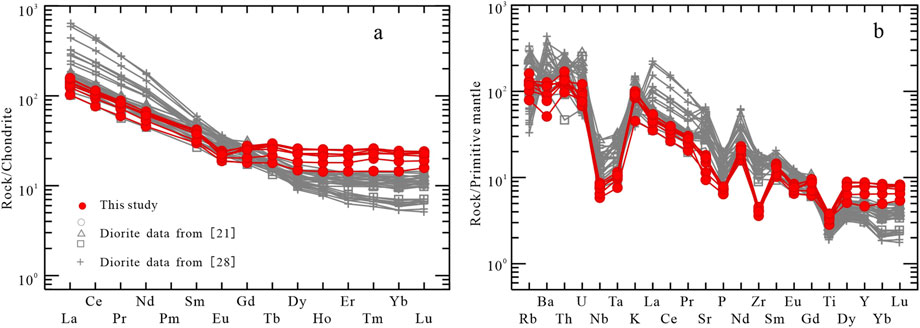
Figure 6. (a) Chondrite- and (b) primitive-mantle-normalized diagrams of the Honghuapu quartz diorite and adjacent dioritic samples. The normalization values were sourced from Sun and McDonough (1989), and the reference data were obtained from Ren (2019) and Liu et al. (2024).
6 Discussion
6.1 Fractional crystallization
The Honghuapu quartz diorite is likely not significantly affected by assimilation and contamination from country rock based on the following reasons. First, all the analytical samples show relatively homogeneous whole-rock major and trace element characteristics, especially consistent REE and trace element patterns. Second, the geochronological results indicate the absence of inherited zircons while capturing relatively older zircons and yield consistent type and age findings for the zircons. Third, the field outcrops do not have documented xenoliths from country rock.
The Honghuapu quartz diorite has a relatively narrow range of SiO2 content from 58.26% to 63.94%. In combination with published data for quartz diorite in the adjacent areas (Ren, 2019), the rocks show a certain evolutionary trend where SiO2 has negative correlations with K2O, CaO, Al2O3, Fe2O3T, MgO, and P2O5 (Figure 7). Therefore, it is suggested that the magma may have undergone a certain degree of fractional crystallization of minerals, such as plagioclase and biotite, as well as a small amount of apatite during its evolution. However, the Honghuapu quartz diorites have no linear relationships with the Huangniupu, Tangzang-Yangjiazhuang, and Fanpu plutons (Figure 7), indicating that the Honghuapu quartz diorite may not have the same source as the latter.
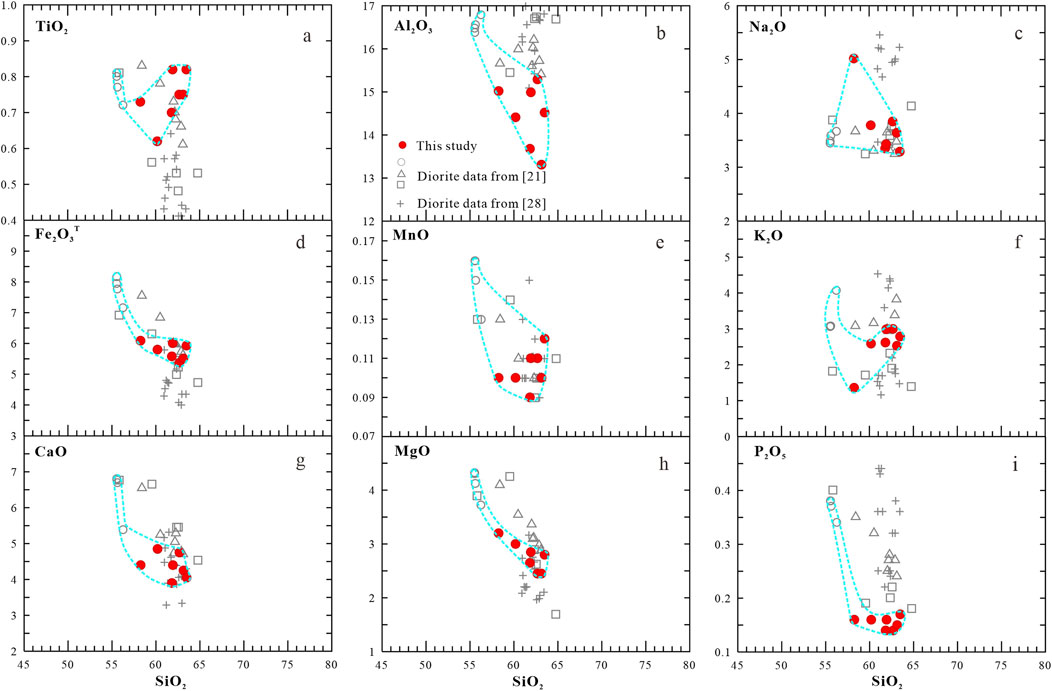
Figure 7. Harker variation diagrams showing correlations between the SiO2 content of Honghuapu quartz diorite and (a) TiO2, (b) Al2O3, (c) Na2O, (d) Fe2O3, (e) MnO, (f) K2O, (g) CaO, (h) MgO, and (i) P2O5 from the adjacent dioritic samples based on reference data from Ren (2019) and Liu et al. (2024).
6.2 Petrogenesis of the Honghuapu quartz diorite
The Honghuapu quartz diorite samples have relatively low MgO contents (2.45%–3.2%) and high FeOt/MgO ratios (1.71–2.02) compared to typical high-magnesium andesite (Tatsumi et al., 2001). In addition, the diorite shows high contents of Y (21.1–39.8 ppm) and Yb (2.45–3.03 ppm) with low ratios of Sr/Y (5–13) and La/Yb (12–14), unlike those of the classic adakite formed by melting of the subduction environment (Hastie and Kerr, 2010). The Honghuapu quartz diorite has high Ba (357–886 ppm) and Sr (198–382 ppm) contents with Ba/Sr ratios in the range of 1.5–2.7, in addition to low Rb content (50.3–102 ppm), indicating high Ba–Sr rock affinity (Figure 8).
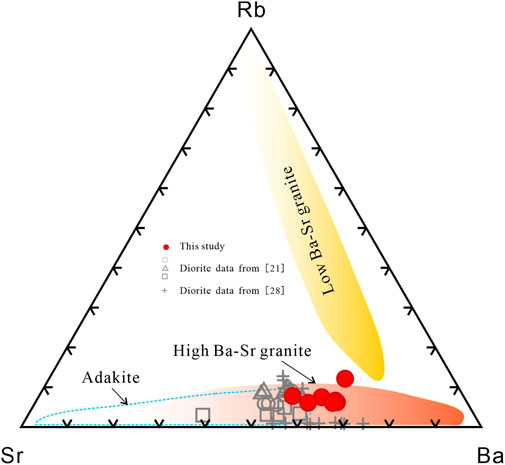
Figure 8. High Ba–Sr granite discrimination diagram of the Honghuapu quartz diorite and adjacent dioritic samples with reference data from Ren (2019) and Liu et al. (2024) (modified from Tarney and Jones (1994)).
Partial melting of the subducted oceanic island arcs or oceanic plateaus (Tarney and Jones, 1994), fractional crystallization of basaltic magmas derived from the enriched mantle and crustal contamination (Fowler et al., 2001; Peng et al., 2013; Wang, 1982), partial melting of the mafic lower crust under high-pressure conditions in the garnet stability field (Choi et al., 2009; Ye et al., 2008), and magma mixing (Zhang et al., 2006) are believed to account for the formation of the high Ba–Sr rock. The melts formed by partial melting of the subducted oceanic islands and oceanic plateaus have consistent REE distribution patterns and weak negative Eu anomalies. However, experimental petrology has shown that the melts produced by the melting of basalt with mid-ocean ridge basalt characteristics are rich in sodium (Beard and Lofgren, 1991), which is inconsistent with the relatively potassium-rich characteristics of the Honghuapu quartz diorite.
Previous studies have shown that the 87Sr/86Sr and εNd(t) values of the Honghuapu pluton are in the ranges of 0.7046–0.7057 and −0.65 to −1.63, respectively (Ren, 2019); however, the two-stage model ages of the in situ zircon Hf isotopes (TDM2 = 1.18–1.22 Ga) suggest that they may have originated from an ancient crustal source. The north Qinling terrane outcrops the Precambrian basement comprising the Qinling, Kuanping, Erlangping, and Danfeng groups (Zhang et al., 2002). However, it is worth noting that these groups preserve not only Precambrian rocks but also outcropped Paleozoic rocks associated with evolution of the Shangdan and Mianlue oceans (Dong et al., 2015). The Qinling group has highly evolved Sr–Nd isotopic compositions (87Sr/86Sr440 = 0.7116–0.7481; εNd(t) = −8.4 to −10.7), while the Mesoproterozoic metamorphosed basalts in the Kuanping, Erlangping, and Danfeng groups have low Ba and Sr contents (Ba = 70.3–76.1 ppm; Sr = 133–165 ppm) (Liu, 2014). The lines of evidence suggest that these are unlikely to be the sources of the Honghuapu high Ba–Sr rock. Therefore, partial melting of the lower crust of the north Qinling terrane is probably not the main mechanism of formation of the Honghuapu quartz diorite.
The Rogart high Ba–Sr rocks in northern Scotland were formed by the partial melting of an enriched mantle and experienced fractional crystallization as well as crustal contamination (Fowler et al., 2001; Fowler et al., 2008). The Honghuapu quartz diorite has petrological and geochemical characteristics similar to those of the Rogart pluton, indicating that it may have a similar origin. Previous studies have shown that the north Qinling terrane had an enriched mantle in the early Paleozoic but that its Sr–Nd isotopic composition is more enriched than that of the Honghuapu pluton; this precludes that an enriched mantle is the main source for the pluton. In addition, the mafic rocks derived from the enriched mantle have high Ba and Sr contents of 537–3,322 ppm and 315–1,418 ppm, respectively (Fowler et al., 2008), which are caused by metasomatism of the overlying mantle wedge by subduction-derived sedimentary melts/fluids. Thus, the Honghuapu quartz diorite may have originated from a relatively depleted enriched mantle source.
The partition coefficient of elements in fluids and melts is an effective measure for distinguishing the main factors causing mantle enrichment (Wang et al., 2014). Generally, Th and Nb have higher contents in sediments but relatively lower contents in hydrous fluids, and Nb is more compatible than Th in these sediments. Rb and Ba are fluid-mobile elements that preferentially enter the dehydration fluids during the subduction process. The Honghuapu quartz diorite has relatively high values of the Th/Zr (0.2–0.3), Rb/Y (2.0–2.6), Ba/La (14.7–26.5), and Ba/Th (49.3–89.9) ratios, which are indicative of the fluid metasomatism affinity (Figure 9). However, a few of the samples were enriched in Th and Nb, implying that the enriched mantle source experienced metasomatism with primary subduction slab-derived hydrous fluid and minor sedimentary melt characteristics.
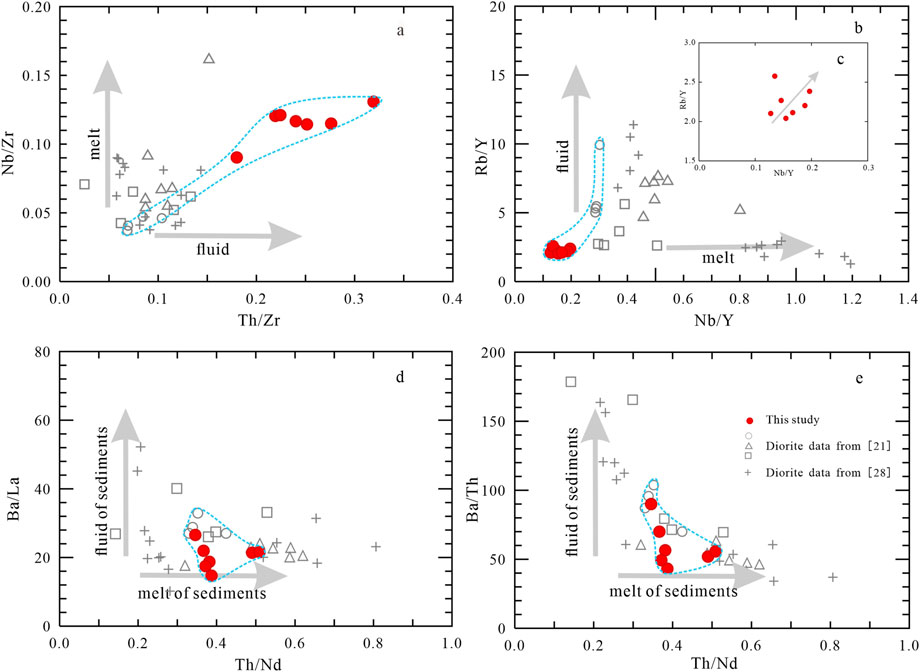
Figure 9. (a) Nb/Zr vs. Th/Zr, (b,c) Rb/Y vs. Nb/Y, (d) Ba/La vs. Th/Nd, and (e) Ba/Th vs. Th/Nd diagrams of the Honghuapu quartz diorite and adjacent dioritic samples based on reference data from Ren (2019) and Liu et al. (2024).
6.3 Geodynamic significance
It is widely accepted that the Shangdan ocean subducted northward beneath the north Qinling terrane during the Cambrian and early–middle Ordovician (Wu and Zheng, 2013; Liu et al., 2016); however, the tectonic background of the Qinling orogenic belt during the late Ordovician to early Silurian remains controversial, and there are four scientific viewpoints, namely, subduction of the oceanic crust (Yao et al., 2017), syn-collisional setting (Liu et al., 2016; Wang et al., 2009; Wang et al., 2013; Zhang et al., 2013), transition framework from oceanic–continental subduction to continent–continent collision (Pei et al., 2009; Zhao et al., 2015), and transition background from continent–continent subduction to collision (Liu et al., 2016).
The Honghuapu high Ba–Sr quartz diorite near the Shangdan suture zone of the north Qinling terrane shows enriched LILEs and depleted HFSEs. The lines of evidence indicate that the high Ba–Sr quartz diorite has a significant fingerprint of arc magmatic rocks (Figure 6). Previous studies show that coeval high Ba–Sr rocks adjacent to the Honghuapu pluton display similar arc-affinity geochemical characteristics (Figures 6, 9), such as the 488–484 Ma hydrous mafic rock (Wang et al., 2014), ca. 435 Ma Baihua pluton (Yan et al., 2007a), and ca. 442 Ma Xiaowangjian leucogranite (Yan et al., 2007b). In addition, the early Paleozoic Caotangou group is a volcanic–sedimentary rock that was formed in an oceanic subduction setting (Yan et al., 2007a; Xu et al., 2014; Chen et al., 2019) and preserves a large number of Ordovician paleontological fossils. The zircon U–Pb dating results of the mafic and felsic volcanic rocks in the Caotangou group show that they were formed at ca. 456–435 Ma (Ren, 2019); these results are consistent with formation age of the Honghuapu high Ba–Sr quartz diorite in this study and adjacent arc-affinity pluton (Wang et al., 2014; Yan et al., 2007a; Yan et al., 2007b).
Trace elements are generally used to discriminate the tectonic environment (Pearce et al., 1984). The Honghuapu high Ba–Sr quartz diorites have low contents of Nb and Y, as shown in the volcanic arc and syn-collision settings in the Nb-Y diagram (Figure 10a). In addition, the high Ba–Sr quartz diorites show relatively low amounts of Rb and display volcanic arc granite affinities in the Rb-Nb+Y diagram (Figure 10b). The lines of evidence indicate that the Honghuapu high Ba–Sr quartz diorites in this contribution could be formed in a subducted environment. Therefore, the outcropped arc-affinity high Ba–Sr quartz diorites and adjacent magmatic rocks could indicate that the Shangdan oceanic crust subducted northward beneath the north Qinling terrane during the late Ordovician to early Silurian; intense mantle convection is also believed to have triggered partial melting of the metasomatized mantle wedge, promoting crustal growth in the north Qinling region during the early Paleozoic.
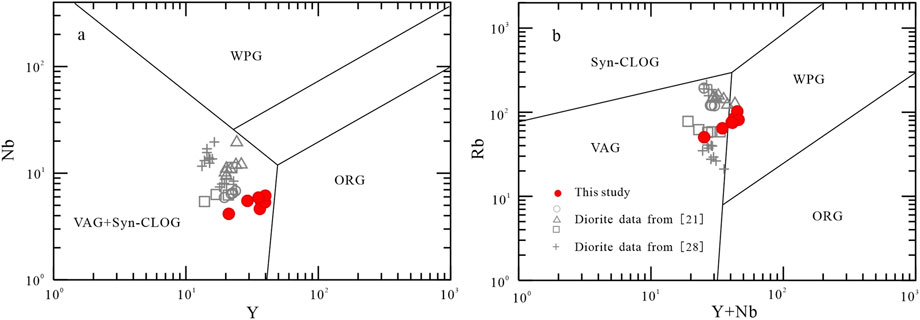
Figure 10. (a) Y vs. Nb and (b) Y+Nb vs. Rb tectonic discrimination diagrams of the Honghuapu quartz diorite and adjacent dioritic samples based on reference data from Ren (2019) and Liu et al. (2024) (modified from Pearce et al. (1984)).
7 Conclusion
(1) Zircon U–Pb dating results of the Honghuapu quartz diorite indicate that it was formed at ca. 445 Ma, which is consistent with the formation ages of the regional plutons.
(2) The Honghuapu quartz diorites show the geochemical fingerprints of high Ba–Sr rocks and are products of partial melting of the lithospheric mantle that has been metasomatized by subduction-derived fluids and sedimentary melts; in addition, it has undergone a certain degree of fractional crystallization.
(3) The Honghuapu high Ba–Sr quartz diorite formed in a continental margin arc setting under the background of northward subduction of the Shangdan ocean crust, which generated numerous late Ordovician to early Silurian medium-acidic magmatic rocks and promoted crustal growth in the north Qinling terrane during the early Paleozoic.
Data availability statement
The raw data supporting the conclusions of this article will be made available by the authors without undue reservation.
Author contributions
BD: writing – review and editing, visualization, conceptualization, formal analysis, and writing – original draft. DZ: writing – original draft, investigation, visualization, and conceptualization. YZ: conceptualization, writing – review and editing, and investigation. ZZ: conceptualization, investigation, and writing – review and editing. XW: investigation, conceptualization, and writing – review and editing. WL: investigation, writing – review and editing, and conceptualization. ZW: conceptualization, investigation, and writing – review and editing.
Funding
The author(s) declare that financial support was received for the research and/or publication of this article. This study was supported by the Public Geological Survey Project of Shaanxi Province (nos. 202501, 202413, 202402, 202103, 201918, 20180301, and 20150101), and Shaanxi Province Youth Science and Technology New Star Plan of Science and Technology Department (no. 2021KJXX-87).
Acknowledgments
The authors thank Professor Xingfu Jiang for the discussions on the geochemical data.
Conflict of interest
The authors declare that the research was conducted in the absence of any commercial or financial relationships that could be construed as a potential conflict of interest.
Generative AI statement
The author(s) declare that no Generative AI was used in the creation of this manuscript.
Publisher’s note
All claims expressed in this article are solely those of the authors and do not necessarily represent those of their affiliated organizations, or those of the publisher, the editors and the reviewers. Any product that may be evaluated in this article, or claim that may be made by its manufacturer, is not guaranteed or endorsed by the publisher.
Supplementary Material
The Supplemnentary Material for this article can be found online at: https://www.frontiersin.org/articles/10.3389/feart.2025.1624653/full#supplementary-material
References
Beard, J. S., and Lofgren, G. E. (1991). Dehydration melting and water-saturated melting of basaltic and andesitic greenstones and amphibolites at 1, 3, and 6. 9 kb. J. Petrol. 32 (2), 365–401. doi:10.1093/petrology/32.2.365
Chen, G. C., Zhang, Y. F., Pei, X. Z., Li, Z. C., Ji, X. J., Wei, J. Q., et al. (2019). Age and geochemical characteristics of acidic tuff in the Longwangou formation of Caotangou group in the Fengxian area, western part of the North Qinling orogenic belt, and tectonic implications. Acta Geol. Sin. 93 (08), 1968–1984. doi:10.19762/j.cnki.dizhixuebao.2019133
Chen, J. L., Xu, X. Y., Wang, H. L., Wang, Z. Q., Zeng, Z. X., Wang, C., et al. (2008). LA-ICPMS Zircon U-Pb dating of Tangzang quartz-diorite pluton in the west segment of North Qinling Mountains and its tectonic significance. Geoscience, (01), 45–52. doi:10.3969/j.issn.1000-8527.2008.01.006
Choi, S. G., Rajesh, V., Seo, J., Park, J. G., Oh, C. W., Pak, S. J., et al. (2009). Petrology, geochronology and tectonic implications of Mesozoic high Ba–Sr granites in the Haemi area, Hongseong Belt, South Korea. Isl. Arc 18 (2), 266–281. doi:10.1111/j.1440-1738.2008.00622.x
Dong, Y. P., Zhang, G. W., Lai, S. C., Zhou, D. W., and Zhu, B. Q. (1999). An ophiolitic tectonic melange first discovered in Huashan area, south margin of Qinling Orogenic Belt, and its tectonic implications. Sci. China Ser. D Earth Sci. 42 (3), 292–302. doi:10.1007/bf02878966
Dong, Y. P., Zhang, G. W., Hauzenberger, C., Fanz, N., Yang, Z., and Liu, X. M. (2011). Palaeozoic tectonics and evolutionary history of the Qinling orogen: evidence from geochemistry and geochronology of ophiolite and related volcanic rocks. Lithos 122 (1-2), 39–56. doi:10.1016/j.lithos.2010.11.011
Dong, Y. P., Zhang, G. W., Zhao, J. X., Yuan, A. P., and Liu, X. M. (2004). Geochemistry of the subduction-related magmatic rocks in the Dahong Mountains, northern Hubei Province —constraint on the existence and subduction of the eastern Mianlüe oceanic basin. Sci. China Ser. D Earth Sci. 47 (4), 366–377. doi:10.1360/02yd0486
Dong, Y. P., Zhang, X. N., Liu, X. M., Li, W., Chen, Q., Zhang, G. W., et al. (2015). Propagation tectonics and multiple accretionary processes of the Qinling Orogen. J. Asian Earth Sci. 104, 84–98. doi:10.1016/j.jseaes.2014.10.007
Eklund, O., Konopelko, D., Rutanen, H., Fröjdö, S., and Shebanov, A. D. (1998). 1.8 Ga Svecofennian post-collisional shoshonitic magmatism in the Fennoscandian shield. Lithos 45 (1-4), 87–108. doi:10.1016/s0024-4937(98)00027-9
Fowler, M., Henney, P., Darbyshire, D. F., and Greenwood, P. B. (2001). Petrogenesis of high Ba–Sr granites: the Rogart pluton, Sutherland. J. Geol. Soc. 158 (3), 521–534. doi:10.1144/jgs.158.3.521
Fowler, M., Kocks, H., Darbyshire, D., and Greenwood, P. B. (2008). Petrogenesis of high Ba–Sr plutons from the northern highlands Terrane of the British Caledonian Province. Lithos 105 (1-2), 129–148. doi:10.1016/j.lithos.2008.03.003
Hastie, A. R., and Kerr, A. C. (2010). Mantle plume or slab window? Physical and geochemical constraints on the origin of the Caribbean oceanic plateau. Earth Sci. Rev. 98, 283–293. doi:10.1016/j.earscirev.2009.11.001
Lai, S. C., Zhang, G. W., Dong, Y. P., Pei, X. Z., and Chen, Y. L. (2004). Geochemistry and regional distribution of ophiolites and associated volcanics in Mianlüe suture, Qinling-Dabie Mountains. Sci. China Ser. D Earth Sci. 47 (4), 289–299. doi:10.1360/02yd0474
Le Maitre, R. W. (1989). A classification of igneous rocks and glossary of terms. Oxford, UK: Blackwell Scientific Publications.
Li, S. G. (1997). Isotopic geochronology and geochemistry of tectonic evolution in the Qinling-Dabie orogenic belt. Edited by J. S. Yu, and Y. S. Li; Research on isotope geochemistry in China. Beijing: Science Press.
Liu, B. X. (2014). Magmatism and crustal evolution in the eastern part of the North Qinling terrane. Hefei: University of Science and Technology of China.
Liu, L., Liao, X. Y., Wang, Y. W., Wang, C., Santosh, M., Yang, M., et al. (2016). Early Paleozoic tectonic evolution of the North Qinling Orogenic Belt in Central China: insights on continental deep subduction and multiphase exhumation. Earth Sci. Rev. 159, 58–81. doi:10.1016/j.earscirev.2016.05.005
Liu, X. M., Gao, S., Yuan, H. L., Hattendorf, B., Gnther, D., Chen, L., et al. (2002). Analysis of 42 major and trace elements in glass standard reference materials by 193nm LA-ICPMS. Acta Petrol. Sin. 18 (3), 408–418. doi:10.3321/j.issn:1000-0569.2002.03.017
Liu, X. Y., Han, X., Liang, T., Li, L. M., Ren, S. L., and Li, J. H. (2024). Petrogenesis and tectonic implications of the Fanpu diorite in the northern Qinling orogenic belt. Chin. J. Geol. 59 (1), 52–64. doi:10.12017/dzkx.2024.004
Pearce, J. A., Harris, N. B., and Tindle, A. G. (1984). Trace element discrimination diagrams for the tectonic interpretation of granitic rocks. J. Petrol. 25 (4), 956–983. doi:10.1093/petrology/25.4.956
Peccerillo, R., and Taylor, S. R. (1976). Geochemistry of eocene CalcAlkaline volcanic rocks from the kastamonu area, northern Turkey. Contrib. Mineral. Petrol. 58, 63–81. doi:10.1007/bf00384745
Pei, X. Z., Ding, S. P., Li, Z. C., Liu, Z. Q., Li, R. B., Feng, J. Y., et al. (2009). Early paleozoic tianshui-wushan tectonic zone of the northern margin of west qinling and its tectonic evolution. Acta Geol. Sin. 83 (11), 1547–1564.
Peng, T. P., Wilde, S. A., Fan, W. M., and Peng, B. X. (2013). Late Neoarchean potassic high Ba–Sr granites in the Taishan granite–greenstone terrane: petrogenesis and implications for continental crustal evolution. Chem. Geol. 344, 23–41. doi:10.1016/j.chemgeo.2013.02.012
Ren, L. (2019). The Caledonian and Indosinian magmatism in the Tangzang area of the Western Qinling orogenic belt and their tectonic implications. Guangzhou: University of Chinese Academy of Sciences (Guangzhou Institute of Geochemistry, Chinese Academy of Sciences.
Sun, S. S., and McDonough, W. F. (1989). Chemical and isotopic systematics of oceanic basalts: implications for mantle composition and processes [J], 42. Geological Society, London, Special Publications, 313–345.
Tarney, J., and Jones, C. (1994). Trace element geochemistry of orogenic igneous rocks and crustal growth models. J. Geol. Soc. 151 (5), 855–868. doi:10.1144/gsjgs.151.5.0855
Tatsumi, Y., Ishikawa, N., Anno, K., Ishizaka, K., and Itaya, T. (2001). Tectonic setting of high-Mg andesite magmatism in the SW Japan arc: K–Ar chronology of the Setouchi volcanic belt. Geophys. J. Int. 144 (3), 625–631. doi:10.1046/j.1365-246x.2001.01358.x
Wang, H., Wu, Y. B., Li, C. R., Zhao, T. P., Qin, Z. W., Zhu, L. Q., et al. (2014). Recycling of sediment into the mantle source of K-rich mafic rocks: Sr–Nd–Hf–O isotopic evidence from the Fushui complex in the Qinling orogen. Contrib. Mineral. Petrol. 168, 1062–19. doi:10.1007/s00410-014-1062-y
Wang, H. L., Xiao, S. W., Xu, X. Y., Zhong, L. W., He, S. P., and Chen, J. L. (2008). Geochronology and significance of the early Mesoproterozoic tectono-magmatic event in the western segment of the North Qinling Mountains. China Geol. Bull. China (10), 1728–1738. doi:10.3969/j.issn.1671-2552.2008.10.015
Wang, H. Z. (1982). The main stages of crustal structure development in China. Earth Sci. (03), 155–178.
Wang, T., Wang, X. X., Tian, W., Zhang, C. L., and Li, S. (2009). North Qinling Paleozoic granite associations and their variation in space and time: implications for orogenic processes in the orogens of central China. Sci. China Ser. D Earth Sci. 52 (9), 1359–1384. doi:10.1007/s11430-009-0129-5
Wang, X. X., Wang, T., and Zhang, C. L. (2013). Neoproterozoic, paleozoic, and mesozoic granitoid magmatism in the qinling orogen, China: constraints on orogenic process. J. Asian Earth Sci. 72, 129–151. doi:10.1016/j.jseaes.2012.11.037
Wu, Y., Qin, M. K., Guo, D. F., Fan, G., Liu, Z. Y., and Guo, G. L. (2022). Metallogenic age of the Guangshigou pegmatite type uranium deposit, North Qinling:constraints from U-Th-Pb dating of monazite. Uranium Geol. 38 (04), 698–706. doi:10.3969/j.issn.1000-0658.2022.38.061
Wu, Y. B., and Zheng, Y. F. (2004). Genesis of zircon and its constraints on interpretation of U- Pb age. Chin. Sci. Bull. 49 (16), 1554–1569. doi:10.1007/bf03184122
Wu, Y. B., and Zheng, Y. F. (2013). Tectonic evolution of a composite collision orogen: an overview on the Qinling–Tongbai–Hong'an–Dabie–Sulu orogenic belt in central China. Gondwana Res. 23 (4), 1402–1428. doi:10.1016/j.gr.2012.09.007
Xu, X. C., Pei, X. Z., Liu, C. J., Li, R. B., and Chen, Y. X. (2014). Geochemical characteristics of the Yinaigou early Paleozoic Caotangou group volcanic rocks in Tianshui of West Qinling Moutains and their geolocical significance. Geol. China 41 (03), 851–865. doi:10.3969/j.issn.1000-3657.2014.03.013
Yan, Q. R., Chen, J. L., Wang, Z. Q., Yan, Z., Wang, T., Liu, Q. G., et al. (2007b). Geochemical characteristics, SHRIMP ages and geological significance of light intrusive rocks in the pillow lava of Xiaowangjian, North Qinling. Sci. China Earth Sci. (10), 1301–1313. doi:10.3321/j.issn:1006-9267.2007.10.003
Yan, Q. R., Wang, Z. Q., Chen, J. L., Yan, Z., Wang, T., Li, Q. G., et al. (2007a). Tectonic setting and SHRIMP age of volcanic rocks in the Xieyuguan and Caotangou groups: implications for the North Qinling orogenic belt. Acta Geol. Sin. (04), 488–584.
Yao, Z., Zhang, Y. F., Yang, T., Yi, P. F., and Zheng, S. X. (2017). Zircon U-Pb geochronology, petrogeochemistry of Huanghuapu plutons in western section of the North Qinling Mountains and their geological significance. Geoscience 31 (06), 1157–1169. doi:10.3969/j.issn.1000-8527.2017.06.005
Ye, H. M., Li, X. H., Li, Z. X., and Zhang, C. L. (2008). Age and origin of high Ba–Sr appinite–granites at the northwestern margin of the Tibet Plateau: implications for early Paleozoic tectonic evolution of the Western Kunlun orogenic belt. Gondwana Res. 13 (1), 126–138. doi:10.1016/j.gr.2007.08.005
Yuan, H. L., Wu, F. Y., Gao, S., Liu, X. M., Xu, P., and Sun, D. Y. (2003). Zircon laser probe U-Pb age determination and rare earth element composition analysis of Cenozoic intrusions in Northeast China. Chin. Sci. Bull., 48(14), 1511–1520. doi:10.1360/csb2003-48-14-1511
Zhang, B. R., Gao, S., and Zhang, H. F. (2002). Geochemistry of Qinling orogenic belt. Beijing: Science Press.
Zhang, C. L., Liu, L., and Wang, T. (2013). Granite magmation during the early paleozoic continental collision in North Qinling. Chin. Sci. Bull. 58 (23), 2323–2329. doi:10.1007/s11434-013-6064-z
Zhang, G. W., Zhang, Z. Q., and Dong, Y. P. (1995). The tectonic properties and tectonic significance of the main tectonic lithostratigraphy units in the Qinling orogenic belt. Acta Petrol. Sin. 11 (2), 101–114
Zhang, H. F., Zhai, M. G., Tong, Y., Peng, P., and Xu, B. L. (2006). The genesis of high Ba-Sr granite in sanfoshan, jiaodong peninsula. Geol. Rev. 52 (1), 43–53. doi:10.3321/j.issn:0371-5736.2006.01.007
Zhao, L. D., Jiao, J. G., Zheng, X. T., Li, F., Fang, Y. M., Yang, H. T., et al. (2024). Garnet texture, geochemistry, and geochronology revealing molybdenum mineralization in the Northern Qinling Belt, Central China. Ore Geol. Rev. 165, 105914. doi:10.1016/j.oregeorev.2024.105914
Zhao, S. J., Li, S. Z., Liu, X., Santosh, M., Somerbille, D., Cao, H. H., et al. (2015). The northern boundary of the Proto-Tethys Ocean: constraints from structural analysis and U–Pb zircon geochronology of the North Qinling Terrane. J. Asian Earth Sci. 113, 560–574. doi:10.1016/j.jseaes.2015.09.005
Keywords: Northern Qinling orogeny, late Ordovician quartz diorite, high Ba–Sr granite, mantle wedge, crustal growth
Citation: Du B, Zhao D, Zhang Y, Zhang Z, Wang X, Li W and Wang Z (2025) Petrogenesis of late Ordovician high Ba–Sr quartz diorite in the northern Qinling orogeny and its geological implications. Front. Earth Sci. 13:1624653. doi: 10.3389/feart.2025.1624653
Received: 07 May 2025; Accepted: 09 June 2025;
Published: 21 July 2025.
Edited by:
Xiao-Ping Xia, Chinese Academy of Sciences (CAS), ChinaCopyright © 2025 Du, Zhao, Zhang, Zhang, Wang, Li and Wang. This is an open-access article distributed under the terms of the Creative Commons Attribution License (CC BY). The use, distribution or reproduction in other forums is permitted, provided the original author(s) and the copyright owner(s) are credited and that the original publication in this journal is cited, in accordance with accepted academic practice. No use, distribution or reproduction is permitted which does not comply with these terms.
*Correspondence: Biao Du, MjAxNTYwMDAyQGVjdXQuZWR1LmNu
 Biao Du
Biao Du Duanchang Zhao1,2
Duanchang Zhao1,2 Zhenkai Zhang
Zhenkai Zhang